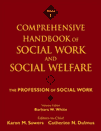Reconceptualizing the Evolution of the American Welfare State
Bruce Jansson
University of Southern California, School of Social Work, Los Angeles, California, US
Search for more papers by this authorBruce Jansson
University of Southern California, School of Social Work, Los Angeles, California, US
Search for more papers by this authorAbstract
Traditional histories of the evolution of the American welfare state have often limited its scope excessively by focusing excessively on social work programs; excluding tax expenditures; failing to discuss sufficiently its community, global, and fiscal context; and omitting important vulnerable populations. This article identifies and discusses eight eras deemed most critical to the American welfare state's evolution, analyzing how it grew by accretion and spurts. It argues that scholars need to devote more attention to two tensions in its evolution: reluctance vs. growth and retrenchment vs. resilience.
References
- Appleby, J. (1992). Liberalism and Republicanism in the historical imagination. Cambridge, MA: Harvard University Press.
- Axinn, J., & Levin, H. (1982). Social welfare: A history of the American response to need. New York: Harper & Row.
- Berkowitz, E., & McQuaid, K. (1980). Creating the welfare state: The political economy of twentieth-century reform. New York: Praeger.
- Boyer, P. (1978). Urban masses and moral order in America, 1920–1920. Cambridge, MA: Harvard University Press.
- Brody, D. (1980). Workers in industrial America: Essays on the twentieth-century struggle. New York: Oxford University Press.
- Davis, K. (2007, April). The challenges posed by diversity to mental health policy. Unpublished lecture at the School of Social Work of the University of Southern California, Los Angeles.
- D'Emilio, J. (1983). Sexual politics, sexual communities: The making of a homosexual minority in the United States, 1940–1970. Chicago: University of Chicago Press.
- Dyer, T. (1980). Theodore Roosevelt and the idea of race. Baton Rouge: Louisiana University Press.
- Edsall, T. (1991). Chain reaction: The impact of race, rights, and taxes on American politics. New York: Norton.
- Friedman, L. (1982). Gregarious saints: Self and community in American abolitionism. Cambridge: Cambridge University Press.
- Gordon, L. (1994). Pitied but not entitled. New York: Free Press.
-
Hacker, J.
(2002).
The divided welfare state: The battle over public and private social benefits in the United States.
New York:
Cambridge University Press.
10.1017/CBO9780511817298 Google Scholar
- Halloran, P. (1989). Boston's wayward children: 1830–1930. London: Associated University Presses.
- Harris, B. (1978). Beyond her sphere: Women and the professions in America. Westport, CT: Greenwood Press.
- Hartz, L. (1955). The liberal tradition in America. New York: Harcourt Brace.
- Jansson, B. (1988). The reluctant welfare state: A history of American social welfare policies. Belmont, CA: Wadsworth.
- Jansson, B. (2001). The sixteen-trillion dollar mistake: How the U.S. bungled its national priorities from the New Deal to the present. New York: Columbia University Press.
- Jansson, B. (2005). The reluctant welfare state: American social welfare policies—Past, present, and future. Belmont, CA: Brooks/Cole.
-
Jansson, B.,
Dodd, S.-J., &
Smith, S.
(2002).
Empowering domestic discretionary spending in federal budget deliberations.
Social Policy Journal,
1(1),
5–18.
10.1300/J185v01n01_02 Google Scholar
- Kawachi, I., Daniels, N., & Robinson, D. (2005). Health disparities by race and class: Why both matter. Health Affairs, 24(2), 343–352.
- Leff, M. (1984). The limits of symbolic reform: The New Deal and taxation, 1933–1939. Cambridge: Cambridge University Press.
- Leiby, J. (1978). A history of social welfare and social work in the United States. New York: Columbia University Press.
- McWilliams, C. (1968). North from Mexico: The Spanish-speaking people of the United States. New York: Greenwood Press.
- Mennel, R. (1973). Thorns and thistles: Juvenile delinquents in the United States, 1825–1940. Hanover, NH: University Press of New England.
- Nash, G. (1976). Social change and the growth of pre-revolutionary urban radicalism. In A. Young (Ed.), The American Revolution: Explorations in the history of American radicalism (pp. 11–30). De Kalb: Northern Illinois University Press.
- Peterson, M. (1975). Portable Thomas Jefferson. New York: Viking Press.
- Pierson, P. (2000). The new politics of the welfare state. In R. Goodwin & D. Mitchell (Eds.), Foundations of the welfare state (pp. 421–465). Northampton, MA: Elgar.
- Rohrbough, M. (1968). The land office business: The settlement and administration of American public lands, 1789–1837. New York: Oxford University Press.
- Sachs, J. (2005). The end of poverty. New York: Penguin Books.
- Sellers, C. (1991). The market revolution: Jacksonian America, 1815–1846. New York: Oxford University Press.
- Shalev, M. (1983). The social democratic model and beyond: Two generations of comparative research on the welfare state. Comparative Social Research, 6, 315–351.
- Skocpol, T. (1995). Social policy in the United States: Future possibilities in historical perspective. Princeton, NJ: Princeton University Press.
- Smith, R. (1993). Patriarch: George Washington and the new American nation. Boston: Houghton Mifflin.
-
Snell, K.
(1985).
Annals of the laboring poor: Social change and agrarian England, 1660–1900.
Cambridge:
Cambridge University Press.
10.1017/CBO9780511599446 Google Scholar
- Stiglitz, J. (2002). Globalization and its discontents. New York: Norton.
- Takaki, R. (1989). Strangers from a different shore. Boston: Little, Brown.
- Thelen, D. (1975). Not classes, but issues. In A. Mann (Ed.), The progressive era: Major issues of interpretation (pp. 4–42). Hindale, IL: Dryden Press.
- Trattner, W. (1979). From poor law to welfare state: A history of social welfare in America. New York: Free Press.
- Tyrell, I. (1979). Sobering up: From temperance to prohibition in antebellum America, 1800–1862. Westport, CT: Greenwood Press.
- T. Walch (Ed.). (1993). Immigrant America: European ethnicity in the United States. New York: Garland.
- Weinstein, J. (1975). It's good for business. In A. Mann (Ed.), The progressive era: Major issues of interpretation (p. 112). Hindale, IL: Dryden Press.
- Witte, J. (1985). The politics and development of the federal income tax. Madison: University of Wisconsin Press.
- Wood, G. (1992). The radicalism of the American revolution. New York: Knopf.
Comprehensive Handbook of Social Work and Social Welfare
Browse other articles of this reference work:



